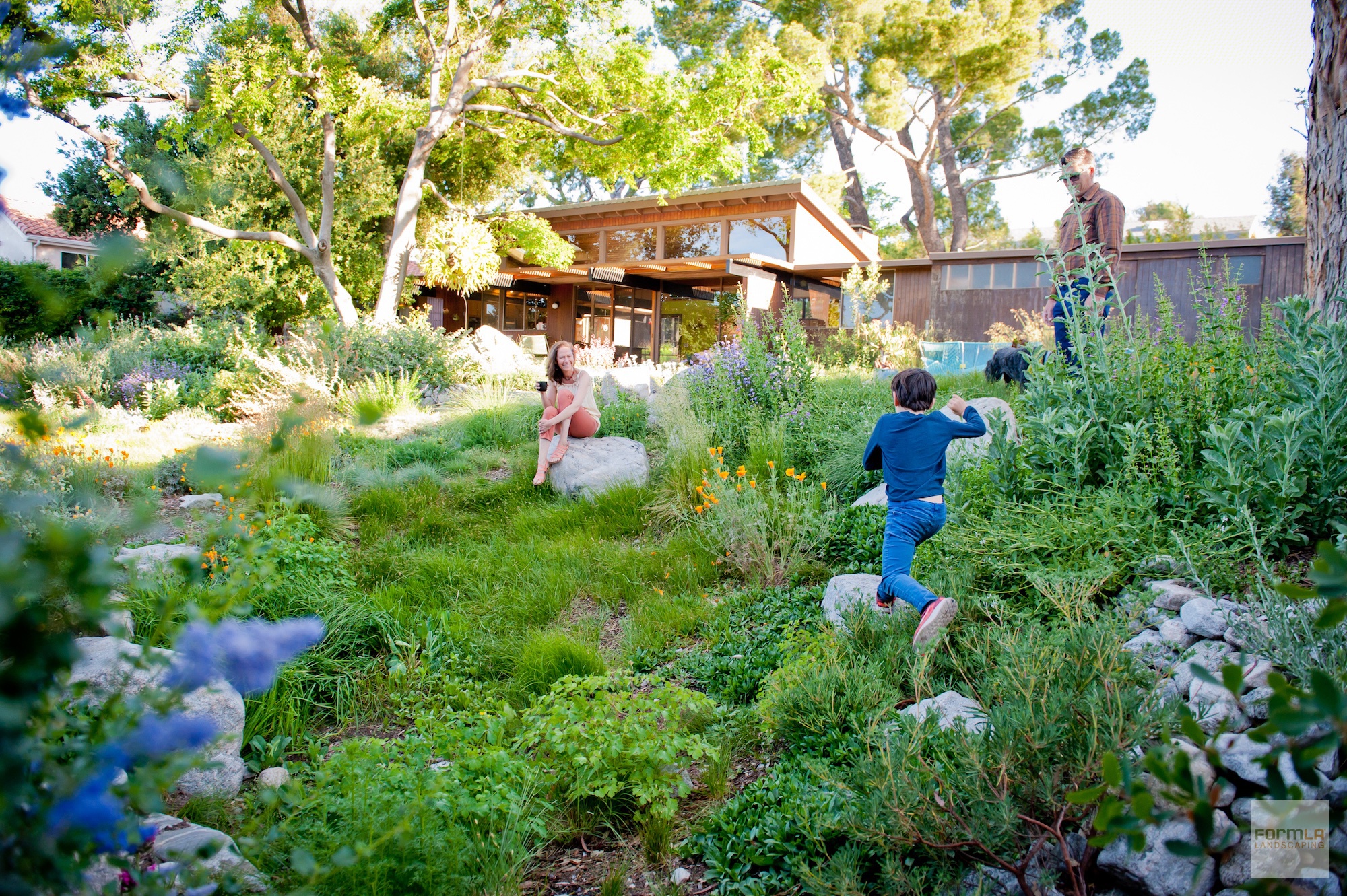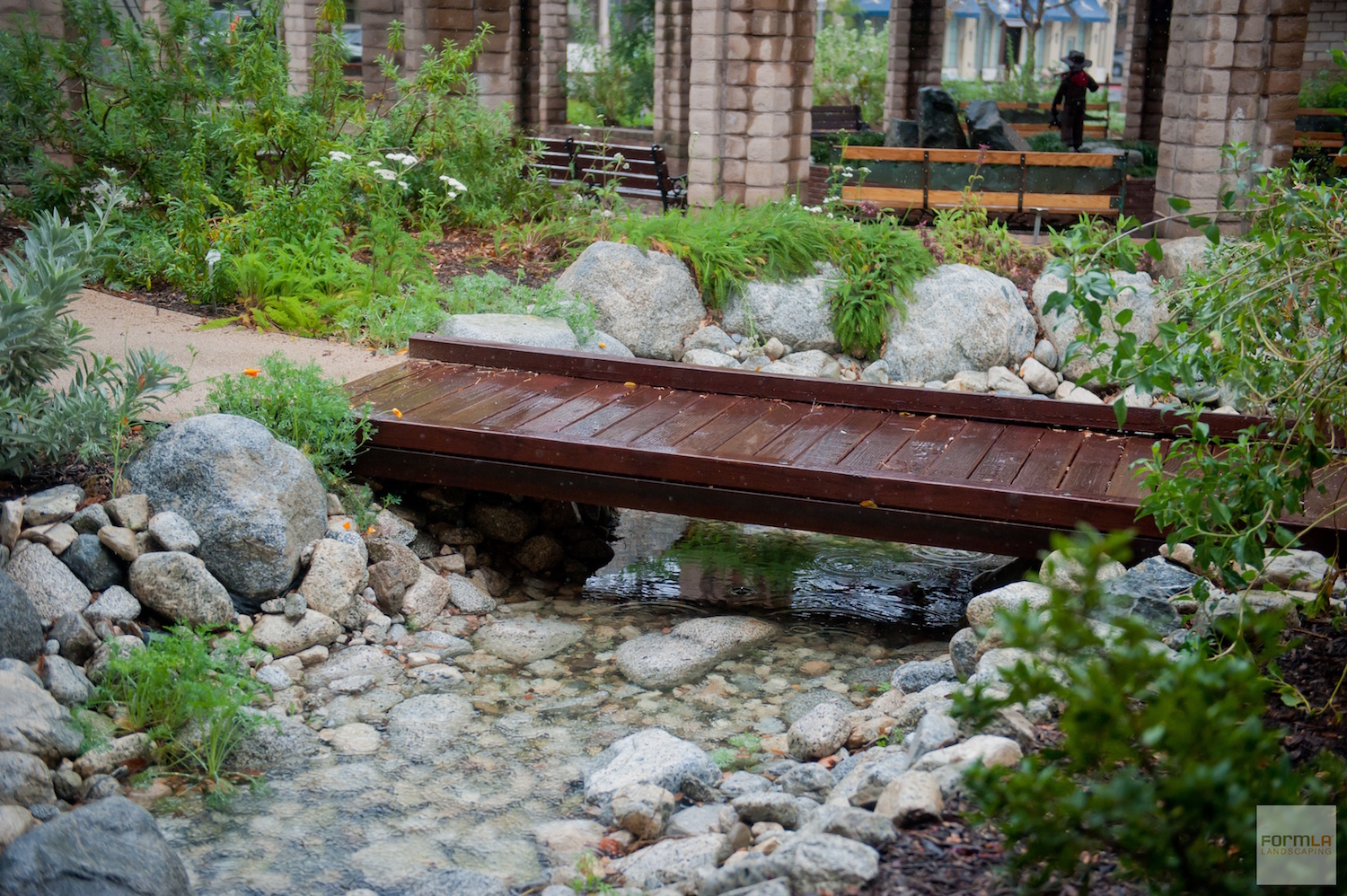Oscar and Kirk Troubleshoot Rain Garden Problems after Strong Storms
January 2023. By Oscar Ortega: LA really tested the metal of rain gardens (aka bioswales or swales) this year. Some estimate we received 600 percent of our normal rainfall – much of it within a week! Incredible.
We love maintaining these features – especially in rain. It means that we get to watch them work – and that usually means seeing how birds delight in the moving water. Even in the worst of times, maintenance of our rain gardens (aka bioswales or swales) consists of simply removing litter and checking any drains and sump-pumps to confirm the effective flow of water.
The ease we have in maintenance can be credited to the skill of our design+build team. While rain gardens can look like simple shifts in topography, technical underground systems ensure water moves safely, quickly and in the right direction.
If you experience problems maintaining a rain garden or with the results of rain, troubleshooting may involve looking below the surface of your garden’s beauty. With that understanding, let’s dive into some of the trouble you may have seen this month.

Problem: A rain garden overflowed and sent water to the street.
Let’s start with the best kind of trouble. As Angelenos generally install rain gardens in the hopes of limiting as much runoff as they can, it can hurt a bit to see some water escape to the street. At the same time, this means your garden has sunk and cleaned a great deal of water. The water it could not sink in this most exceptional of years did no damage to your garden or home.
Tip: If you’ve completed the maintenance previously noted, remind yourself this is an exceptional year, and that you are already doing a great deal to support LA! Even a petite rain garden can absorb 25 percent of the stormwater that would otherwise runoff to the ocean. Consider expanding your bioswale if you can do so while maintaining space for the other garden activities that give you joy.

Problem: Rain garden foliage fails to thrive after rain.
A rain garden’s ability to sink water generally enhances the performance of the whole garden. If your rain garden is full of riparian loving native plants or an appropriate native meadow grass, the foliage should thrive in both drought and deluge.
Tip: If your rain garden foliage is stressed, it may be worth considering whether it is appropriate to the area. Many non-native riparian plants prefer warm rain or more subtle shifts in temperature. If your foliage is on our rain garden list, it was at the end of its growth cycle and may have looked tired before the rains. We would expect cooler temperatures and precipitation to kick start a growth spurt and keep it lush and leafy through summer. If this very-appropriate foliage is failing, it may indicate that the substructure under your rain garden isn’t adequately moving water down through the root zone.

Problem: Overflow impacted the design of your garden.
If overflow from a rain garden impacted your garden’s shape, it is possible your bioswale is simply a topographical shift that lacks important underlying infrastructure.
Tip: Consider adapting your garden design to include graduated topography to maintain the “redesign” completed by the rain. While we think of this rain as unusual, adapting to the unusual will save you the need to renovate your garden with every “extra” El Nino. Alternatively, you may want to renovate the bioswale to incorporate more effective substructure.

Problem: Overflow entered or pooled near a structure.
In addition to quickly sinking water before it can run toward your home or other structures, an effectively designed and built rain garden should direct water away from them.
Tip: If you find water entering or challenging the foundation of a structure, check for obstructions in any drains, vessles or pumps meant to direct water. If all are clear, evaluate the topography. The overflow of the bioswale should be lower than the topography around the house and other structures.

Problem: Liquified soil impacted the foundation of your home.
We sure hope you don’t have this problem! It is more likely to occur in the flat areas of Los Angeles where clay soils dominate. These soils become mud when over-hydrated. Where there is clay soil, sophisticated substructure is essential to bioswale performance and safety.
Tip: It’s important to evaluate the soil characteristics as well as your property’s topography. Not all sights are appropriate for bioswales. Some soils don’t percolate water effectively, so they turn soil to mud. On hillsides, this can create slippage of soil – nobody wants that! Also if the water doesn’t sink, the soil can become anaerobic. Anaerobic soil “grows” dead plants and thriving mosquitos. Consult with a professional to ensure your rain garden generates only good for you and LA.
Do you have a question about rain garden design, building or maintenance? Check out our Instagram for timely tips, or reach out to our team.
More Information
See Rain Garden Styles
See Our Rain Garden Plant Palette
Prepare for Rain, Floods and Slides
Get More Maintenance Tips